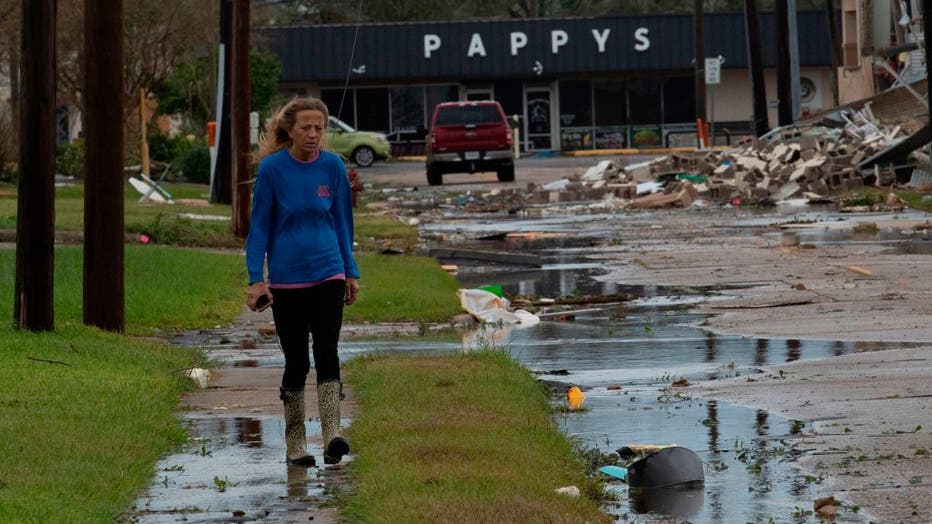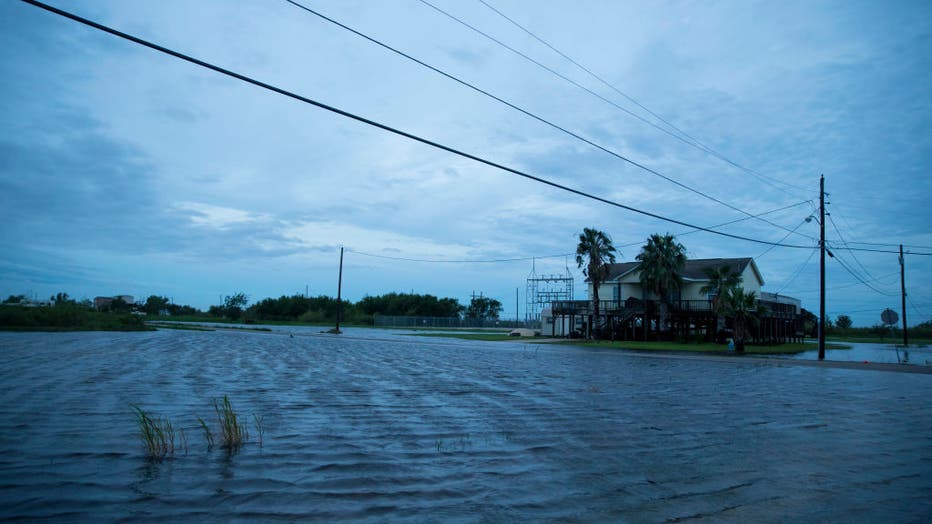‘Houses that are totally gone’: 4 dead as Tropical Storm Laura exits Louisiana, leaving wake of destruction
LAKE ARTHUR, La. (AP) - One of the strongest hurricanes ever to strike the U.S. pounded the Gulf Coast with wind and rain early Thursday morning, but Laura rapidly weakened and was downgraded to a tropical storm by afternoon.
As of 4 p.m. CDT, Laura was packing winds at 65 mph and moving north into Arkansas at 15 mph.
According to the National Oceanic and Atmospheric Administration (NOAA), dangerous storm surge and elevated water levels will persist for the next few hours along the Gulf Coast from Sabine Pass, Texas to Port Fourchon, Louisiana.
“In some areas where surge penetrated far inland, flood waters will not fully recede for several days,” NOAA reported.
Damaging winds are expected to continue near the center of Laura over sections of Northern Louisiana and Arkansas Thursday.
Widespread flash flooding along streams, urban areas and roadways will continue across portions of Louisiana, Mississippi and Arkansas. The threat of heavy rainfall will persist as the system moves north and then east into the middle Mississippi, lower Ohio and Tennessee Valleys and Mid-Atlantic States Friday into the weekend.
Hurricane Laura roared ashore in Louisiana near the Texas border around 1 a.m. CDT Thursday, unleashing a fearsome wall of seawater and killing at least one person.
Louisiana took the brunt of the damage when the Category 4 storm barreled over Lake Charles, an industrial and casino city of 80,000 people. Laura's powerful gusts blew out windows in tall buildings and tossed around glass and debris. Police spotted a floating casino that came unmoored and hit a bridge.
Drone video showed water surrounding homes with much of their roofs peeled away. Gov. John Bel Edwards reported Louisiana's first fatality — a 14-year-old girl who died when a tree fell on her home in Leesville, more than 100 miles inland.

A woman walks down a street filled with debris after the passing of Hurricane Laura in Lake Charles, Louisiana on August 27, 2020. (Photo by ANDREW CABALLERO-REYNOLDS/AFP via Getty Images)
The hurricane’s top wind speed of 150 mph put it among the most powerful systems on record in the U.S.
“It looks like 1,000 tornadoes went through here. It’s just destruction everywhere," said Brett Geymann, who rode out the storm with three family members in Moss Bluff, near Lake Charles. He described Laura passing over his house with the roar of a jet engine around 2 a.m.
RELATED: 'Glass falling everywhere': Video, images show damage in the aftermath of Hurricane Laura
“There are houses that are totally gone. They were there yesterday, but now gone," he said.
An apparent chemical fire broke out near Lake Charles, sending up plumes of smoke visible for miles. The source of the blaze was not immediately clear, but Edwards urged nearby residents to shelter in place and turn off air conditioners.
Hours after the system made landfall, initial reports offered hope that the destruction might be somewhat less than originally feared, but a full damage assessment could take days. Wind and rain blew too hard for authorities to check for survivors in some hard-hit places. Meanwhile, Laura began weakening as it churned toward Arkansas, which was under an unusual tropical storm warning.
Hundreds of thousands of people were ordered to evacuate ahead of the hurricane, but not everyone fled from the area, which was devastated by Hurricane Rita in 2005.
“There are some people still in town, and people are calling ... but there ain’t no way to get to them,” Tony Guillory, president of the Calcasieu Parish Police Jury, said over the phone from a Lake Charles government building that was shaking from the storm.
Guillory said he hoped the stranded people could be rescued later in the day, but he feared that blocked roads, downed power lines and floodwaters could get in the way.
“We know anyone that stayed that close to the coast, we’ve got to pray for them, because looking at the storm surge, there would be little chance of survival,” Louisiana Lt. Gov. Billy Nungesser told ABC’s Good Morning America.
RELATED: Hurricane Laura: Wind, rain pummel coasts of Louisiana, Texas as ferocious storm makes landfall
More than 600,000 homes and businesses were without power in the two states, according to the website PowerOutage.Us, which tracks utility reports.
Arkansas Gov. Asa Hutchinson declared an emergency ahead of Laura and set aside $250,000 for the state to prepare for the storm’s impact in his state. Hutchinson said the state will have search-and-rescue teams on standby.
Forecasters had warned that the storm surge of 15 to 20 feet would be “unsurvivable” and could push 40 miles inland. They expected “catastrophic” damage along a stretch of coast from Lake Charles to Port Arthur, Texas. Damaging winds extended outward as far as 175 miles (280 kilometers), according to the hurricane center.
More than 580,000 coastal residents were ordered to join the largest evacuation since the coronavirus pandemic began and many did, filling hotels and sleeping in cars since officials did not want to open large shelters that could invite more spread of COVID-19.
But in Cameron Parish, where Laura came ashore, Nungesser said 50 to 150 people refused pleas to leave and planned to endure the storm, some in elevated homes and even recreational vehicles.

Hurricane Laura came ashore bringing rain and high winds to the eastern part of the state. (Photo by Eric Thayer/Getty Images)
“It’s a very sad situation,” said Ashley Buller, assistant director of emergency preparedness. “We did everything we could to encourage them to leave.”
Becky Clements, 56, did not take chances. She evacuated from Lake Charles after hearing that it could take a direct hit. With memories of Rita's destruction almost 15 years ago, she and her family found an Airbnb hundreds of miles inland.
“The devastation afterward in our town and that whole corner of the state was just awful,” Clements recalled. “Whole communities were washed away, never to exist again.”
Federal Emergency Management Agency Administrator Pete Gaynor urged people in Laura's path to stay home, if that's still safe. “Don't go out sightseeing. You put yourself, your family at risk, and you put first responders at risk," he told “CBS This Morning.”
FEMA has plenty of resources ready to help survivors, Gaynor said. Edwards mobilized the National Guard to help, and state Department of Wildlife crews had boats prepared for water rescues.
Forecasters expected a weakened Laura to cause widespread flash flooding in states far from the coast. Little Rock, Arkansas, expected gusts of 50 mph and a deluge of rain through Friday. The storm was so powerful that it could regain strength after turning east and reaching the Atlantic Ocean, potentially threatening the densely populated Northeast.
Laura hit the U.S. after killing nearly two dozen people on the island of Hispaniola, including 20 in Haiti and three in the Dominican Republic, where it knocked out power and caused intense flooding.
It was the seventh named storm to strike the U.S. this year, setting a new record for U.S. landfalls by the end of August. The old record was six in 1886 and 1916, according to Colorado State University hurricane researcher Phil Klotzbach.
Laura was tied with five other storms for fifth most powerful hurricane, behind the 1935’s Labor Day storm, 1969’s Camille, 1992’s Andrew and 2004’s Charley, Klotzbach said.
___
Deslatte reported from Baton Rouge, Louisiana, and Plaisance from Stephensville, Louisiana. Associated Press contributors include Jeff Martin in Marietta, Georgia; John L. Mone in Port Arthur, Texas; Paul J. Weber in Austin, Texas; Seth Borenstein in Kensington, Maryland; Juan A. Lozano in Houston; Jake Bleiberg in Dallas; Jay Reeves in Birmingham, Alabama; Jill Bleed in Little Rock, Arkansas; Julie Walker in New York and Sophia Tulp in Atlanta.
Stephanie Weaver contributed to this story.

